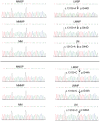Role of stem cells in human uterine leiomyoma growth
- PMID: 22570742
- PMCID: PMC3343011
- DOI: 10.1371/journal.pone.0036935
Role of stem cells in human uterine leiomyoma growth
Abstract
Background: Uterine leiomyoma is the most common benign tumor in reproductive-age women. Each leiomyoma is thought to be a benign monoclonal tumor arising from a single transformed myometrial smooth muscle cell; however, it is not known what leiomyoma cell type is responsible for tumor growth. Thus, we tested the hypothesis that a distinct stem/reservoir cell-enriched population, designated as the leiomyoma-derived side population (LMSP), is responsible for cell proliferation and tumor growth.
Principal findings: LMSP comprised approximately 1% of all leiomyoma and 2% of all myometrium-derived cells. All LMSP and leiomyoma-derived main population (LMMP) but none of the side or main population cells isolated from adjacent myometrium carried a mediator complex subunit 12 mutation, a genetic marker of neoplastic transformation. Messenger RNA levels for estrogen receptor-α, progesterone receptor and smooth muscle cell markers were barely detectable and significantly lower in the LMSP compared with the LMMP. LMSP alone did not attach or survive in monolayer culture in the presence or absence of estradiol and progestin, whereas LMMP readily grew under these conditions. LMSP did attach and survive when directly mixed with unsorted myometrial cells in monolayer culture. After resorting and reculturing, LMSP gained full potential of proliferation. Intriguingly, xenografts comprised of LMSP and unsorted myometrial smooth muscle cells grew into relatively large tumors (3.67 ± 1.07 mm(3)), whereas xenografts comprised of LMMP and unsorted myometrial smooth muscle cells produced smaller tumors (0.54 ± 0.20 mm(3), p<0.05, n = 10 paired patient samples). LMSP xenografts displayed significantly higher proliferative activity compared with LMMP xenografts (p<0.05).
Conclusions: Our data suggest that LMSP, which have stem/reservoir cell characteristics, are necessary for in vivo growth of leiomyoma xenograft tumors. Lower estrogen and progesterone receptor levels in LMSP suggests an indirect paracrine effect of steroid hormones on stem cells via the mature neighboring cells.
Conflict of interest statement
Figures





References
-
- Walker CL, Stewart EA. Uterine fibroids: the elephant in the room. Science. 2005;308:1589–1592. - PubMed
-
- Okolo S. Incidence, aetiology and epidemiology of uterine fibroids. Best Pract Res Clin Obstet Gynaecol. 2008;22:571–588. - PubMed
-
- Wallach EE, Vlahos NF. Uterine myomas: an overview of development, clinical features, and management. Obstet Gynecol. 2004;104:393–406. - PubMed
-
- Stewart EA. Uterine fibroids. Lancet. 2001;357:293–298. - PubMed
-
- Szotek PP, Chang HL, Zhang L, Preffer F, Dombkowski D, et al. Adult mouse myometrial label-retaining cells divide in response to gonadotropin stimulation. Stem Cells. 2007;25:1317–1325. - PubMed
Publication types
MeSH terms
Substances
Grants and funding
LinkOut - more resources
Full Text Sources
Other Literature Sources
Medical
Research Materials

